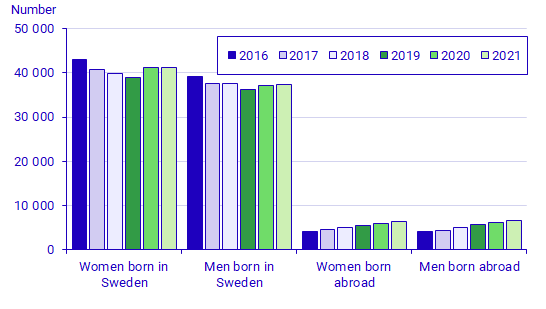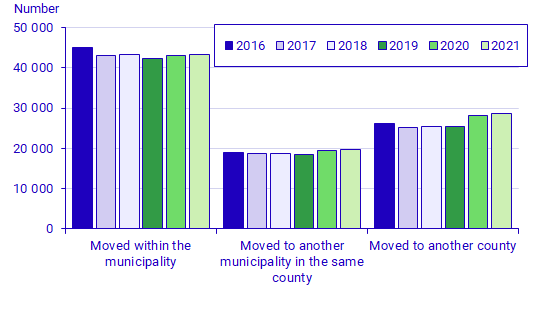Demographic analysis: Young people leaving the parental household during the coronavirus pandemic
More young people moved away from home in 2020 and 2021
Statistical news from Statistics Sweden 2022-11-16 8.00
The annual number of young people who moved out of their parents’ household has declined in recent years. But the number of movers increased in the 2020 and 2021. The increase was greatest among native-born women.
In the report Young people leaving the parental household during the coronavirus pandemic, published today, Statistics Sweden presents statistics on young people aged 18 to 24 who moved out of their parental household during the period 2016–2021.
Trend reversal in 2020 and 2021
Between 2016 and 2019, the annual number of young people who moved out of their parental home decreased from 90,200 to 86,200. The downward trend reversed in 2020 when 90,500 persons left home. In 2021, the number of movers increased further to 91,600.
The recent increase is not explained by changes in the number of 18-24 year olds in the population. The number of movers in relation to the population aged 18–24 has varied between 105 and 107 per 1,000 in the years 2016–2019. In 2020 and 2021, it increased to 113 and 114 per 1,000, respectively.
Largest increase among native-born women
Among young people born in Sweden, the annual number of women that move out of their parental home is greater than that of men. In addition, the increase in 2020 and 2021 was greatest among women than among men.
Regarding young people born abroad, the number of women and men who have moved away from their parental home has increased every year during the period 2016–2021. There was no noticeably greater increase in 2020 and 2021.

Increased migration across county borders
When young women and men leave their parental home, it is most common that they move to another household within the home municipality, i.e. within the same municipality in which they lived with their parents.
In recent years, roughly 25,000 young people per year have moved away from the county in which they lived together with their parents. In the years 2020 and 2021, the corresponding figures were over 28,000. The number of people who moved within the home municipality or to another municipality in the same county has been more stable over time. This means that the recent increase in moving away from home is largely due to increased migration across county borders, i.e. young people who have moved away from the county in which they lived together with their parents.

Increased nest leaving in most counties
In most counties, the number of 18–24 year olds who have moved out of their parental household increased in 2020 compared to 2019. The increase was greatest in Stockholm County and the number of movers decreased slightly in Norrbotten County, Västerbotten County and Västernorrland County.
The number of young people who moved away from home also increased in most counties in 2021 compared to 2020. During this period, the increase was greatest in Skåne County. The number of people moving out of the parental household decreased slightly in the counties of Dalarna, Gotland, Jämtland, Värmland, Västerbotten and Östergötland.
Connection with the corona pandemic
Following the restrictions that were introduced in Sweden and in the rest of the world to reduce the spread of the coronavirus, a weakened labour market ensued. It is likely that this has had an impact on the number of young people moving away from home. It is common for more young people to enrol in higher education during periods of greater uncertainty in the labour market. This can lead to more people moving out of the parental home, particularly if the studies take place in another municipality. For example, in the spring semester of 2021 the number of applicants for higher education was the highest since the spring semester of 2009, according to statistics from the Swedish Council for Higher Education (UHR). But measures to reduce the spread of the infection may have limited, to some extent, moves away from home due to studies. The Public Health Agency of Sweden recommended distance learning for high schools, colleges and universities in the spring of 2020. The recommendation was removed at the beginning of the summer of 2021 and students could return to on-site teaching during the fall semester of 2021.
Definitions and explanations
Persons who resided in the same household as at least one biological parent at the end of the year and did not reside with any biological parent at the end of the following year are counted here as having moved away from the parental home.
Compared to native-born youth, the study of moving away from the parental home among foreign-born youth is more complicated, due to the annual variations in immigration in this group. In addition, a large proportion of foreign-born persons aged 18–24 immigrated to Sweden without their parents. By definition, these young people cannot move out of the parental home. The statistics for foreign-born young people must therefore be interpreted with caution.
The statistics are based on information from Statistics Sweden's Population register. Information about the quality of the statistics, methods and more can be found in a chapter at the end of each report (in Swedish).
Publication
Feel free to use the facts from this statistical news but remember to state Source: Statistics Sweden.
